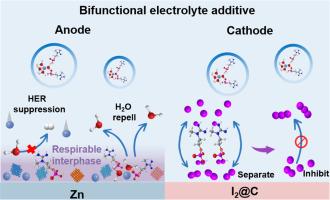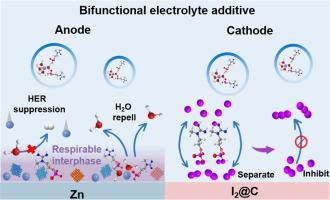Bifunctional electrolyte additive sustains high efficient zinc-iodine batteries via respirable-interphase formation and polyiodide ion suppression
IF 20.2
1区 材料科学
Q1 CHEMISTRY, PHYSICAL
引用次数: 0
Abstract
Aqueous zinc–iodine batteries hold immense potential for grid-scale storage owing to their inherent safety, cost-effectiveness, and eco-friendliness. However, their commercialization is hindered by limited cycle life caused by irreversible Zn plating/stripping and I2/I− redox reaction. Herein, we propose 1-(2-hydroxyethyl)-1-methylguanidine dihydrogen phosphate (HMDP) as an effective bifunctional additive that not only stabilizes Zn anode by forming a respirable-interphase but also suppresses the generation of polyiodide ion at the cathode by separating I2 and I−. The Zn//Cu cells with HMDP achieve a Coulombic efficiency of 99.63 % over 650 cycles (2 mA cm−2, 1 mAh cm−2) and retain 85.83 % initial efficiency after 7-day calendar aging. Surprisingly, the Zn//Zn symmetric cells with HMDP deliver an ultra-long cycle-life of 5150 h (0.5 mA cm−2, 0.5 mAh cm−2) thanks to the formation of respirable-interphase. Meanwhile, the Zn//I2 full cells retain 81.04 % capacity at 2 A g−1 after >3000 cycles due to the suppression of polyiodide ion. This work establishes strategies of I2–I− separator and respirable-interphase to design advanced zinc-iodine batteries.


双功能电解质添加剂通过呼吸间相形成和多碘离子抑制来维持高效锌碘电池
由于其固有的安全性、成本效益和生态友好性,水锌碘电池在电网规模存储方面具有巨大的潜力。然而,由于不可逆的镀锌/剥离和I2/I−氧化还原反应导致循环寿命有限,阻碍了它们的商业化。在此,我们提出1-(2-羟乙基)-1-甲基胍二氢磷酸(HMDP)作为一种有效的双功能添加剂,不仅可以通过形成呼吸间相来稳定Zn阳极,还可以通过分离I2和I−来抑制阴极多碘离子的产生。在650次循环(2 mA cm−2,1 mAh cm−2)中,具有HMDP的Zn/ Cu电池的库仑效率达到99.63%,在7天的日历老化后仍保持85.83%的初始效率。令人惊讶的是,由于呼吸间期的形成,具有HMDP的Zn//Zn对称电池提供了5150小时(0.5 mA cm - 2, 0.5 mAh cm - 2)的超长循环寿命。同时,由于多碘离子的抑制,在2 A g−1下循环3000次以上后,Zn//I2充满电池的容量仍保持在81.04%。本工作建立了I2-I -分离器和呼吸间相的策略来设计先进的锌碘电池。
本文章由计算机程序翻译,如有差异,请以英文原文为准。
求助全文
约1分钟内获得全文
求助全文
来源期刊

Energy Storage Materials
Materials Science-General Materials Science
CiteScore
33.00
自引率
5.90%
发文量
652
审稿时长
27 days
期刊介绍:
Energy Storage Materials is a global interdisciplinary journal dedicated to sharing scientific and technological advancements in materials and devices for advanced energy storage and related energy conversion, such as in metal-O2 batteries. The journal features comprehensive research articles, including full papers and short communications, as well as authoritative feature articles and reviews by leading experts in the field.
Energy Storage Materials covers a wide range of topics, including the synthesis, fabrication, structure, properties, performance, and technological applications of energy storage materials. Additionally, the journal explores strategies, policies, and developments in the field of energy storage materials and devices for sustainable energy.
Published papers are selected based on their scientific and technological significance, their ability to provide valuable new knowledge, and their relevance to the international research community.
 求助内容:
求助内容: 应助结果提醒方式:
应助结果提醒方式:


